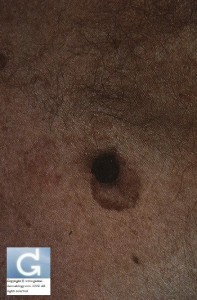Perte de cheveux (Calvitie) chez l'homme et chez la femme
- Nous vous conseillons de faire examiner vos grains de beauté par un dermatologue et surtout si:
- vous en avez plus de 100
- un individu dans votre famille a eu le mélanome.
- vous avez plus de 40 ans
- vous avez une peau claire (phototypes I et II), des yeux clairs
- vous attrapez souvent des coups de soleil
- vous êtes inquiets
- Nous conseillons de faire examiner vos grains de beauté une fois par année par un dermatologue. Ce dernier examinera vos grains de beauté à l’aide d’un appareil appelé dermatoscope voire un appareil appelé vidéomicroscope.
- Afin d’augmenter les chances de détecter un grain de beauté anormal susceptible d’être un mélanome nous vous conseillons d’examiner vous-même vos grains de beauté un fois par mois.Vous serez ainsi plus conscients de l’apparence des grains de beauté que vous avez et si des nouveaux font leur apparition.
- Pour faire cela:
- isolez-vous dans une pièce privée et bien illuminée
- placez-vous devant un « miroir tête aux pieds » en tenant un miroir amovible afin de pouvoir examiner votre dos et les régions non accessibles au regard directement (dos, arrière des jambes).
- soyez systématiques en examinant votre corps de la tête au pied (devant et derrière):
- tête
- cou
- bras (droit et gauche)
- torse et haut du dos
- ventre, organes génitaux et bas du dos/fesses
- jambe (droite et gauche)
- terminer par les paumes des mains et entre les doigts, plantes des pieds et entre orteils, et muqueuses (yeux, bouche et orifice anal)
- demandez à quelqu’un de regarder votre cuir chevelu en écartant les cheveux à l’aide d’un sèche-cheveux.
- De manière générale vous devez consultez un dermatologue si un grain de beauté:
- est de forme irrégulière (A comme asymétrie)
- a une bordure irrégulière (B comme bordure)
- a plusieurs couleurs (C comme couleur)
- a un diamètre supérieur à 5mm (D comme diamètre)
- a changé depuis la dernière fois (E comme évolution).
- Vous devez faire particulièrement attention et consulter si un grain de beauté:
- nouveau apparait
- grandit
- saigne spontanément
- ne guérit pas après un traumatisme
Contributeurs:
Dr Christophe Hsu – dermatologue. Genève, Suisse
Related posts

